Abstract
The distribution and quantitation of enteroviruses among water, suspended solids, and compact sediments in a polluted estuary are described. Samples were collected sequentially from water, suspended solids, fluffy sediments (uppermost layer of bottom sediments), and compact sediment. A total of 103 samples were examined of which 27 (26%) were positive for virus. Polioviruses were recovered most often, followed by coxsackie B viruses and echoviruses 7 and 29. Virus was found most often attached to suspended solids: 72% of these samples were positive, whereas only 14% of water samples without solids yielded virus. Fluffy sediments yielded virus in 47% of the samples, whereas only 5% of compact bottom-sediment samples were positive. When associated with solids, poliovirus and rotavirus retained their infectious quality for 19 days. The same viruses remained infectious for only 9 days when freely suspended in seawater. Collection of suspended solids at ambient water pH appears to be very useful for the detection of virus; it has advantages over collecting and processing large volumes of water, with accompanying pH adjustment and salt addition for processing.
Full text
PDF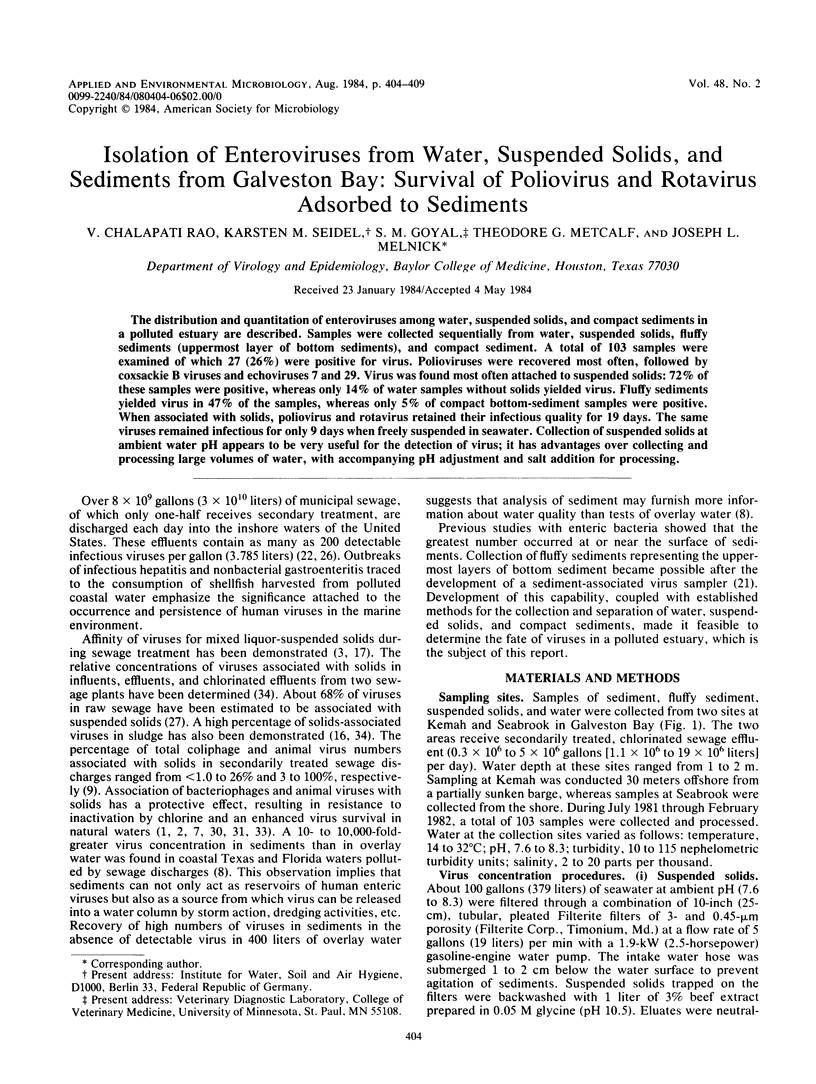
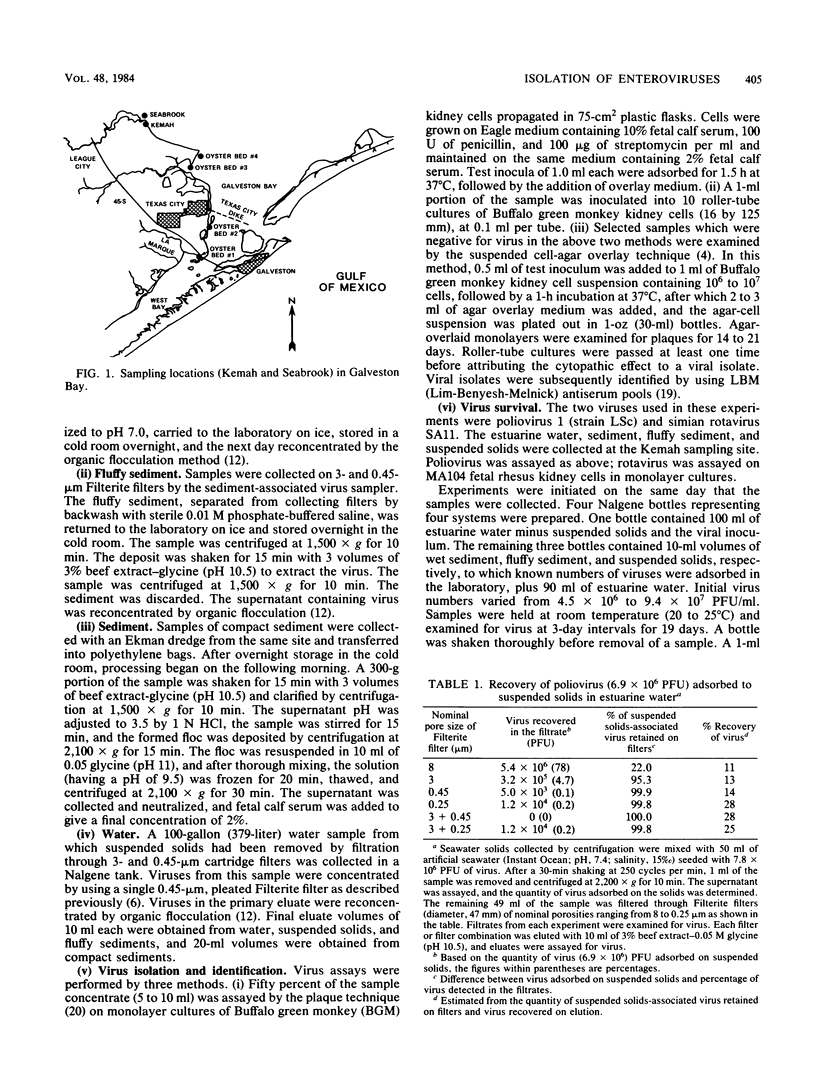
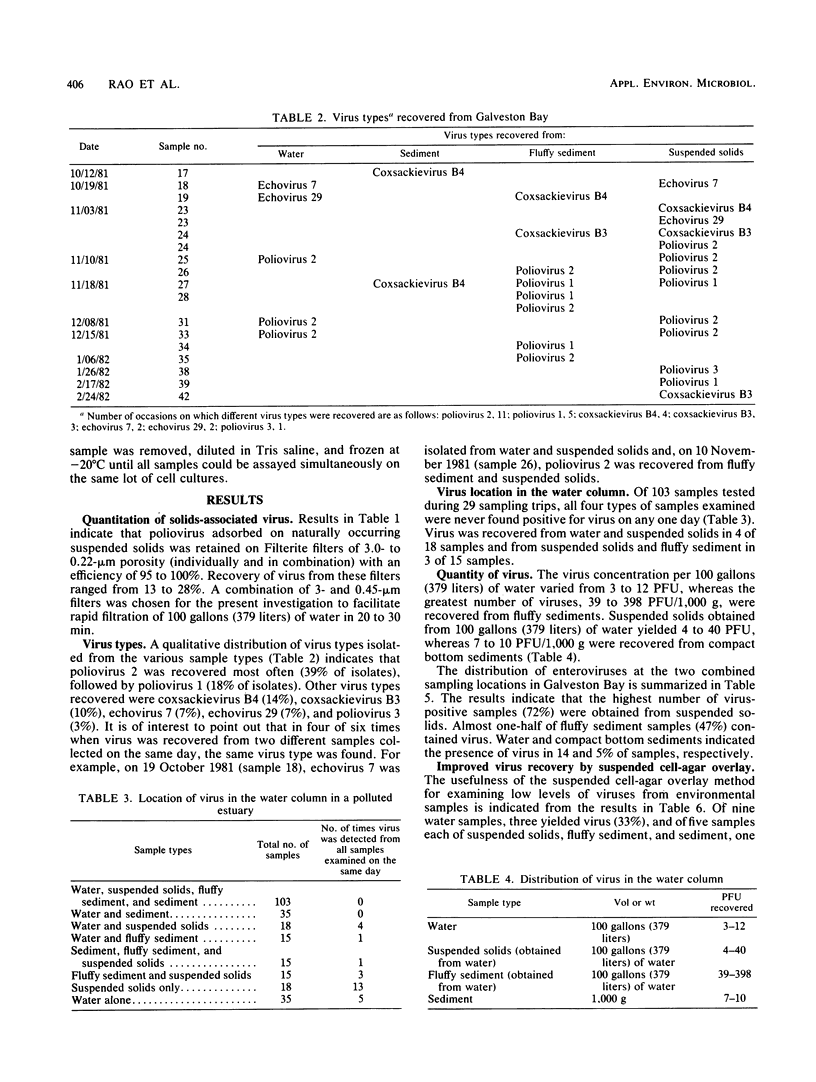
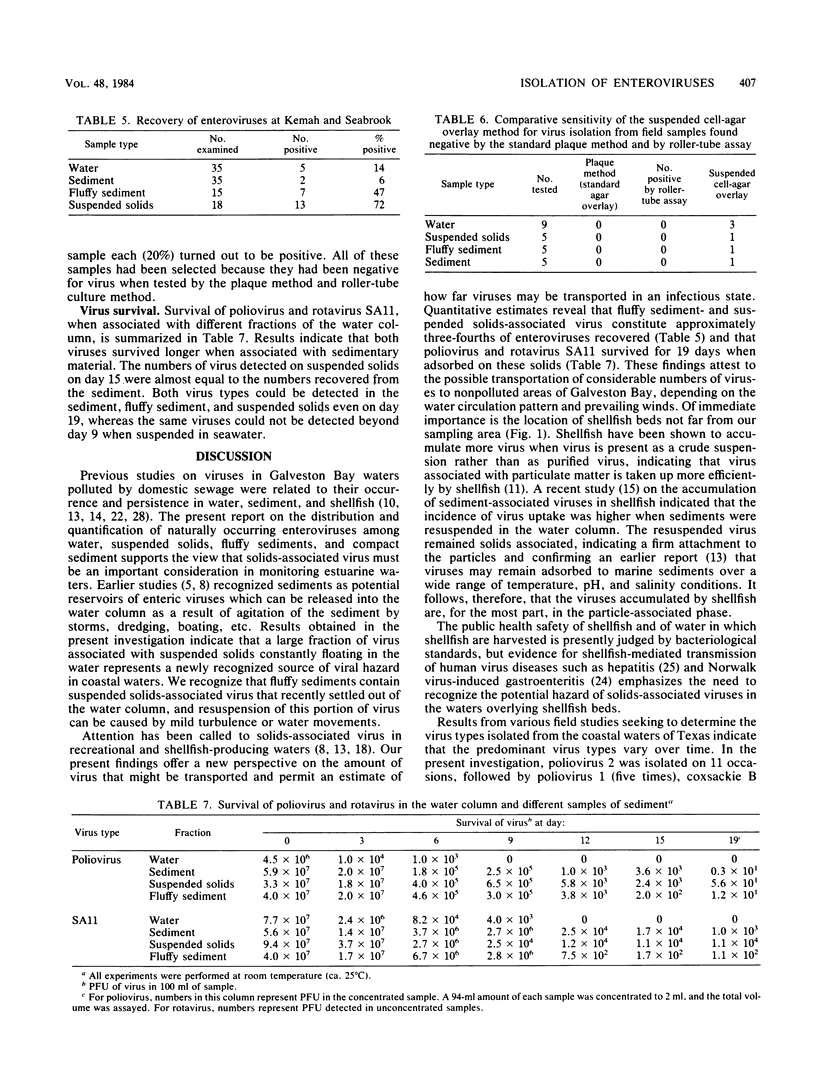
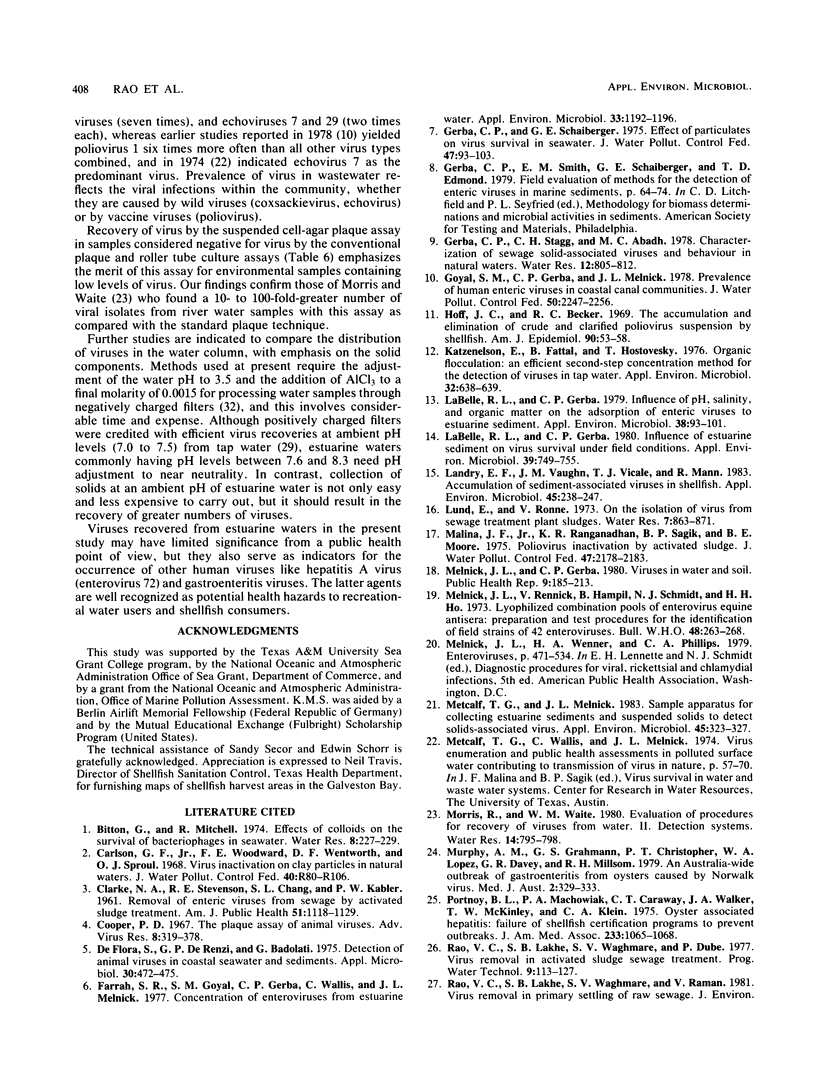
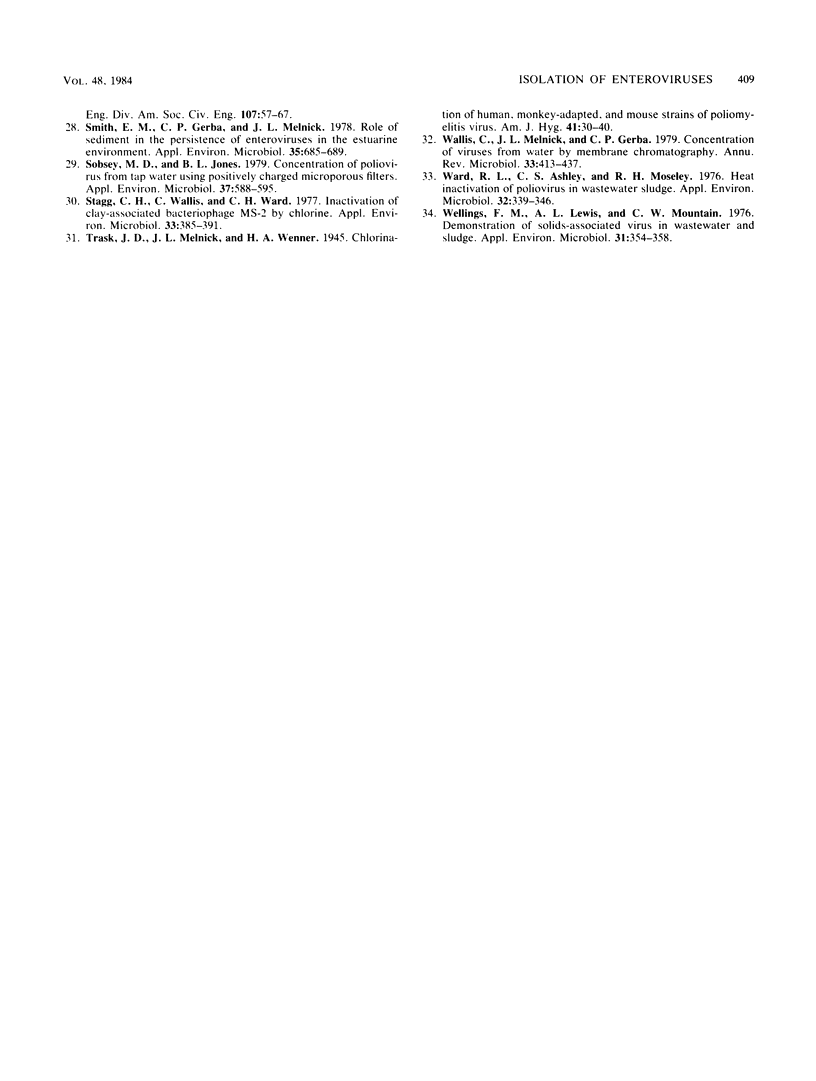
Selected References
These references are in PubMed. This may not be the complete list of references from this article.
- CLARKE N. A., STEVENSON R. E., CHANG S. L., KABLER P. W. Removal of enteric viruses from sewage by activated sludge treatment. Am J Public Health Nations Health. 1961 Aug;51:1118–1129. doi: 10.2105/ajph.51.8.1118. [DOI] [PMC free article] [PubMed] [Google Scholar]
- COOPER P. D. The plaque assay of animal viruses. Adv Virus Res. 1961;8:319–378. doi: 10.1016/s0065-3527(08)60689-2. [DOI] [PubMed] [Google Scholar]
- De Flora S., De Renzi G. P., Badolati G. Detection of animal viruses in coastal seawater and sediments. Appl Microbiol. 1975 Sep;30(3):472–475. doi: 10.1128/am.30.3.472-475.1975. [DOI] [PMC free article] [PubMed] [Google Scholar]
- Farrah S. R., Goyal S. M., Gerba C. P., Wallis C., Melnick J. L. Concentration of enteroviruses from estuarine water. Appl Environ Microbiol. 1977 May;33(5):1192–1196. doi: 10.1128/aem.33.5.1192-1196.1977. [DOI] [PMC free article] [PubMed] [Google Scholar]
- Gerba C. P., Schaiberger G. E. Effect of particulates on virus survival in seawater. J Water Pollut Control Fed. 1975 Jan;47(1):93–103. [PubMed] [Google Scholar]
- Hoff J. C., Becker R. C. The accumulation and elimination of crude and clarified poliovirus suxpensions by shellfish. Am J Epidemiol. 1969 Jul;90(1):53–61. doi: 10.1093/oxfordjournals.aje.a121049. [DOI] [PubMed] [Google Scholar]
- Katzenelson E., Fattal B., Hostovesky T. Organic flocculation: an efficient second-step concentration method for the detection of viruses in tap water. Appl Environ Microbiol. 1976 Oct;32(4):638–639. doi: 10.1128/aem.32.4.638-639.1976. [DOI] [PMC free article] [PubMed] [Google Scholar]
- LaBelle R. L., Gerba C. P. Influence of estuarine sediment on virus survival under field conditions. Appl Environ Microbiol. 1980 Apr;39(4):749–755. doi: 10.1128/aem.39.4.749-755.1980. [DOI] [PMC free article] [PubMed] [Google Scholar]
- LaBelle R. L., Gerba C. P. Influence of pH, salinity, and organic matter on the adsorption of enteric viruses to estuarine sediment. Appl Environ Microbiol. 1979 Jul;38(1):93–101. doi: 10.1128/aem.38.1.93-101.1979. [DOI] [PMC free article] [PubMed] [Google Scholar]
- Landry E. F., Vaughn J. M., Vicale T. J., Mann R. Accumulation of sediment-associated viruses in shellfish. Appl Environ Microbiol. 1983 Jan;45(1):238–247. doi: 10.1128/aem.45.1.238-247.1983. [DOI] [PMC free article] [PubMed] [Google Scholar]
- Malina J. F., Jr, Ranganathan K. R., Sagik B. P., Moore B. E. Poliovirus inactivation by activated sludge. J Water Pollut Control Fed. 1975 Aug;47(8):2178–2183. [PubMed] [Google Scholar]
- Melnick J. L., Gerba C. P. Viruses in water and soil. Public Health Rev. 1980 Jul-Dec;9(3-4):185–213. [PubMed] [Google Scholar]
- Melnick J. L., Rennick V., Hampil B., Schmidt N. J., Ho H. H. Lyophilized combination pools of enterovirus equine antisera: preparation and test procedures for the identification of field strains of 42 enteroviruses. Bull World Health Organ. 1973;48(3):263–268. [PMC free article] [PubMed] [Google Scholar]
- Metcalf T. G., Melnick J. L. Simple apparatus for collecting estuarine sediments and suspended solids to detect solids-associated virus. Appl Environ Microbiol. 1983 Jan;45(1):323–327. doi: 10.1128/aem.45.1.323-327.1983. [DOI] [PMC free article] [PubMed] [Google Scholar]
- Murphy A. M., Grohmann G. S., Christopher P. J., Lopez W. A., Davey G. R., Millsom R. H. An Australia-wide outbreak of gastroenteritis from oysters caused by Norwalk virus. Med J Aust. 1979 Oct 6;2(7):329–333. doi: 10.5694/j.1326-5377.1979.tb104133.x. [DOI] [PubMed] [Google Scholar]
- Portnoy B. L., Mackowiak P. A., Caraway C. T., Walker J. A., McKinley T. W., Klein C. A., Jr Oyster-associated hepatitis. Failure of shellfish certification programs to prevent outbreaks. JAMA. 1975 Sep 8;233(10):1065–1068. doi: 10.1001/jama.233.10.1065. [DOI] [PubMed] [Google Scholar]
- Smith E. M., Gerba C. P., Melnick J. L. Role of sediment in the persistence of enteroviruses in the estuarine environment. Appl Environ Microbiol. 1978 Apr;35(4):685–689. doi: 10.1128/aem.35.4.685-689.1978. [DOI] [PMC free article] [PubMed] [Google Scholar]
- Sobsey M. D., Jones B. L. Concentration of poliovirus from tap water using positively charged microporous filters. Appl Environ Microbiol. 1979 Mar;37(3):588–595. doi: 10.1128/aem.37.3.588-595.1979. [DOI] [PMC free article] [PubMed] [Google Scholar]
- Stagg C. H., Wallis C., Ward C. H. Inactivation of clay-associated bacteriophage MS-2 by chlorine. Appl Environ Microbiol. 1977 Feb;33(2):385–391. doi: 10.1128/aem.33.2.385-391.1977. [DOI] [PMC free article] [PubMed] [Google Scholar]
- Wallis C., Melnick J. L., Gerba C. P. Concentration of viruses from water by membrane chromatography. Annu Rev Microbiol. 1979;33:413–437. doi: 10.1146/annurev.mi.33.100179.002213. [DOI] [PubMed] [Google Scholar]
- Ward R. L., Ashley C. S., Moseley R. H. Heat inactivation of poliovirus in wastewater sludge. Appl Environ Microbiol. 1976 Sep;32(3):339–346. doi: 10.1128/aem.32.3.339-346.1976. [DOI] [PMC free article] [PubMed] [Google Scholar]
- Wellings F. M., Lewis A. L., Mountain C. W. Demonstration of solids-associated virus in wastewater and sludge. Appl Environ Microbiol. 1976 Mar;31(3):354–358. doi: 10.1128/aem.31.3.354-358.1976. [DOI] [PMC free article] [PubMed] [Google Scholar]


